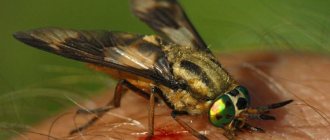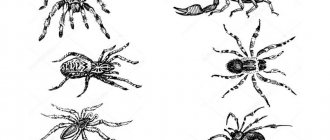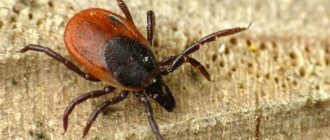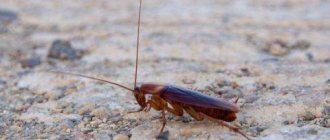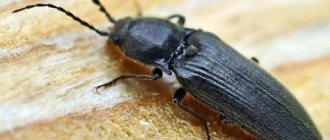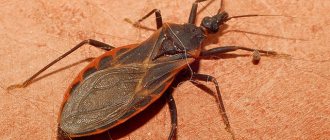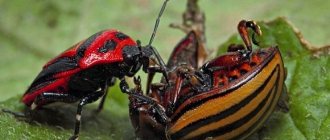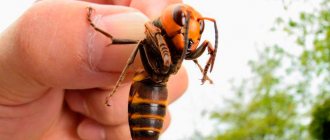Scientists are very obsessive people and often experiment on themselves. Briton John Haldane broke his spine to study the overload experienced by submariners. Russian scientist Ilya Mechnikov deliberately infected himself with typhus, and his colleague Nikolai Gamaleya drank a cocktail of cholera pathogens. American biologist Justin Schmidt has experienced the bites of more than 150 species of insects, and has compiled his own sting strength scale. Referring to the Schmidt scale data, our short review presents the most painful stinging insects in ascending order of pain level.
11
Sweet bee
In Russian, such bees were given the name “sweat”, as they are attracted by the aroma of salt in human sweat. The most numerous is the Halictidae family, numbering more than 3,500 species.
They often attack people, especially those who want to brush them off. The bee takes hand waves as a sign of aggression towards itself. In terms of bite strength, with an indicator of “1.0” it is at the lowest level.
Schmidt compared the stings of these bees to a small charge of electricity connected to every hair on the body.
10
Fleas
A person can see for himself what the bites of insects that parasitize on the body of dogs and cats look like. Fleas live in the wild among grass, sand, and basements. Pets enter a house or apartment through cracks in the floor, doorways. They are active in the evening, but if the premises are heavily infested, they bite during the day.
On a note!
The flea bites at three points because it pierces the skin several times during one meal. The process itself may be invisible, then a small red spot appears, dried blood in the center, slight swelling, severe itching.
Bites come in varying degrees of intensity. If one individual ate, there are no serious consequences, the unpleasant symptoms disappear within a day, the epidermis is restored within a week. With numerous attacks, skin lesions lead to the formation of dermatitis and an allergic reaction. Special treatment is required. Use ointments for insect bites.
Fire ants
The bites of the Solenopsis invicta species (red fire ants) are especially painful. The bite is comparable to a burn, which is why this type of ant is nicknamed fire ants.
The entomologist, giving a score of 1.2, called the bite sudden and sharp, but not irritating. Pain occurs when the poison solenopsin is injected, which causes redness at the site of the bite.
For people with weak immunity and increased allegorical reactions, small insects can pose a mortal danger.
9
Mosquitoes
Small insects begin to attack at the end of May, when the air temperature approaches +20 degrees Celsius. Huge colonies live in the wild near water bodies, shady forests, as well as in basements and city parks. They enter a house or apartment through open windows and doors. You can suffer from insect bites in your own home, without leaving its walls, or on a picnic.
The moment of the bite is felt immediately or after the pest has flown away. It all depends on the pain threshold and sensitivity of the person. Who was bitten is determined by external symptoms. Mosquito attacks in most cases do not cause serious consequences and are limited to a local reaction on the skin.
- swelling;
- slight swelling;
- redness up to 1 cm in diameter;
- severe, unpleasant itching.
On a note!
Insect bites in children are more severe and go away on their own within a week or require the use of special medications. The peculiarity of mosquito bites is that they bite on open areas of the skin, leaving random marks. Photos of insect bites are presented below.
Mosquito bite
Acacia ants / Acacia ant
Ants living on trees and shrubs belong to the large genus Pseudomyrmex. Found in Central and South America. The second species name is Bullhorn acacia ant.
They prefer to settle on acacia trees, as its juice protects them from natural enemies. The bite, rated 1.8 on the Schmidt scale, is quite painful.
Those who have encountered ants say that the bite is pinpoint, accompanied by piercing pain. It feels as if the body has been pierced with a sharp needle or squeezed between the two surfaces of a stapler.
8
Dolichovespula maculata
Because of its appearance, the annoying insect is also called the White-faced Hornet. There are clearly visible white spots on the insect's head. Lives in the Northern Hemisphere of the planet. In America they are called yellow-jackets, and there are 18 species in total on the planet.
It makes its paper nests near human habitation, and often aggressively defends them with its entire flock. The bite is painful, intense, accompanied by a burning sensation and needle-like pain.
A wasp from the genus Dolichovespula is firmly entrenched in the top ten painfully stinging insects with a score of 2.0 points.
Social wasps / Vespinae
The large subfamily of Foldoptera is distinguished by the complex social organization of its colonies and the bizarre architectural forms of its nests.
The bite is painful, burning, as if a cigarette is being put out on the body. Particularly dangerous for people with allergies. On the Schmidt scale, 2.0 points, but according to those who encountered wasps in childhood, it is much higher.
These insects have a rather aggressive disposition, and they are able to defend themselves and their home by stabbing their sharp sting into the body several times.
6
Honey bee / Apis mellifera
A beneficial insect that has been used by humans since ancient times to produce honey and wax. But they bite quite painfully. The bite site immediately turns red and there is a slight swelling.
The strength of the bite is rated at 2.0 points, and the pain is comparable to a severe burn. After stinging, the bee dies as it leaves a sting in the victim's body.
Many people volunteer to be bitten, as it is believed that this is an excellent remedy for radiculitis.
5
Hornet/Vespa
The largest representative of the genus Vespa mandarinia grows up to 5.5 cm, and in addition, all species are equipped with a sharp sting. Hornets have spread throughout all regions of the Northern Hemisphere, except for the Far North.
By thrusting their sting, they release venom that contains acetylcholine. Because of this, the sting of these flying insects is more painful than that of ordinary wasps. On the pain scale it is rated at 2 points. Can bite several times in a row during one attack.
The poison, when it enters the body, causes allergies, and a person can die from anaphylactic shock if medical assistance is not provided in a timely manner.
By the way, on our website most-beauty.ru there is an interesting article about the most poisonous and dangerous insects in Australia.
4
Red American Reaper Ant / Pogonomyrmex barbatus
The inhabitant of the forests of North America has one of the most powerful poisons among all insects on the planet. The sting force according to the Schmidt Sting Pain Index is 3 points.
Highly organized ants create colonies with up to 12 thousand families. They are omnivores. And in addition to plant food, they happily hunt other insects, amphibians and mammals. They hunt in large groups, jointly attacking the prey.
The bite is doubly painful because the harvester ant first bites with its powerful jaws and then inserts a sharp sting that is hidden in the abdomen.
3
Popular folk remedies for domestic bloodsuckers
The following representatives of blood-sucking insects are found in residential buildings: bed bugs, lice and fleas. Note that it is quite difficult to get rid of these parasites.
Firstly, because they are most active at night and attack unnoticed, most often when a person is sleeping.
Secondly, because they are very small in size and have a protective coloring.
Thirdly, they are designed by nature itself in such a way that they cannot exist without a person or his warm-blooded pet (cat, dog, budgie, etc.) - the instinct of procreation pushes them towards a human home.
Fourthly, some of them can live in basements and attics, entering the apartment only to drink blood and then go home.
Hence the conclusion - it is extremely difficult to defeat bedbugs, fleas and lice. It’s simpler and more correct to prevent them from appearing in the apartment at all. How to do it?
From time immemorial, our ancestors used various herbs to repel insects. The smell of wild rosemary, wormwood, tansy, chamomile, and lavender is hated by parasites, so it was recommended to place flowers, leaves and branches of these plants under sheets and mattresses.
Home hygiene was maintained by adding natural or synthetic vinegar, salt, and herbal decoctions to the water for dusting.
They even practiced enchanting the home and other witchcraft rituals, for example, collecting harmful insects that had settled in the house and throwing them into the coffin of the deceased or onto an ice floe during freeze-up. It was believed that, following their brothers, the rest of the domestic blood-sucking insects would leave the home.
Paper wasps
The most numerous and extensive subfamily in the family of social wasps, including 25 genera and more than 800 species. Some are distinguished by primitive behavior, and some are highly organized.
Both of them sting painfully, and on the scale their bite is rated at 3.0 points. The sting is released, and a burning pain is felt followed by numbness at the site of the bite.
In primitive animals, a nest of 15–20 individuals is formed around one female. Sometimes nests contain up to 100 individuals. Such paper wasps are also found in Russia, but fortunately, they do not sting as often as their relatives on the North American continent.
Horsefly and gadfly
Measures to protect against horseflies and gadflies are the same as against any midge. The same repellents, the same ointments and scents.
A horsefly bite is very painful and allergenic. You can quickly relieve swelling and itching with an aqueous solution of baking soda.
Another good remedy for the consequences of bites is a mash made from glycerin, alcoholic iodine and ammonia. You need to mix 40 g of iodine and alcohol, add 60 g of glycerin and shake. When the mixture becomes discolored, the drug that relieves swelling and itching is ready. It will not scare away the insect, but will alleviate the condition of the bitten one and neutralize the effect of the anticoagulant injected into the wound. The bottle should be shaken before application, as glycerin tends to flake off and sink to the bottom.
Gadflies, unlike horseflies, do not drink blood, but lay eggs under the skin of warm-blooded animals. Having bitten a small hole, the female lays eggs in it, from which larvae hatch, feeding on the blood and tissues of the mammal. Fortunately, in our country, gadflies attacking humans are not very common. Our gadflies are more dangerous for livestock - sheep, goats, cows, etc. A well-fed and healthy animal is rarely bitten. As a rule, gadflies attack weak and sick individuals when they go down to a pond to drink water or sleep in the open air.
Horseflies infect animals with tularemia and anthrax, and gadflies infect animals with myiases.
Gadflies and horse flies cannot tolerate the smell of birch tar, black elderberry, anise, cloves and kerosene.
Wasps of the genus Pepsis
Hunters of tarantulas, such wasps have settled throughout the planet, and grow up to 5.4 cm in length. The wasp received its species name due to the fact that it often hunts dangerous arachnids.
Those who have encountered bites say that it is a fierce, blinding pain, as if the body was electrocuted. Schmidt rated this pain at 4.0 points. They have a thick, sharp sting that leaves a mark on the body.
A fairly strong insect that can easily cope with large tarantulas and other spiders that are much larger in size.
1
#1. Ticks - insect bites #1
And finally, ticks. We have already talked about these insects several times. And all because meeting them is both unpleasant and dangerous to health and life . Moreover, during the hunting season, ticks can cause concern to many people throughout the vast territory of both Russia and the whole world.
__________________
You can read more about ticks here:
– Tick-borne encephalitis is the No. 1 disease caused by a tick bite
– Borreliosis – disease No. 2 caused by a tick bite
– Tick-borne diseases No. 3
– Do I need to be vaccinated against ticks?
– How do ixodid ticks attack?
__________________
Mite
A tick bite is usually not felt . Most often you can see it when it begins to swell with blood. Some ticks are capable of causing paralysis with their venom. However, these are not found on Russian territory. Attacks by our domestic parasites pose a greater risk of transmitting pathogens of dangerous diseases . Many of them affect the nervous system, causing irreversible damage to internal organs, making them disabled or even killing.
With a tick bite you can catch numerous types of fevers , typhus , encephalitis , Lyme borreliosis , tularemia and many other diseases. The most famous in our area are the taiga tick, forest tick, dog tick and others.
By
Tropical Bullet Ant / Paraponera clavata
First on our list of powerfully stinging insects on most-beauty is a large ant that lives in the tropical forests of South America. In English they are called Bullet ant, and on the pain scale they have the highest level of painful sting of 4.0+.
In addition, they have poison. Adults grow up to 2.5 cm, with a sting length of 3.5 mm. A highly organized and aggressive insect. Everyone in the colony has their own role, and the ant strictly adheres to it all its life. They attack the victim in a group.
Some Indian tribes use them in an elaborate initiation rite where young men wear gloves filled with painfully stinging ants. Michael Smith's body map of pain.
PS
Bed bugs
The bites of different insects differ from each other, but in some ways they have similarities. A bug attack resembles a mosquito attack; swelling, redness, a blister, and severe itching appear. But bed bugs infest all year round, regardless of the temperature outside the window.
Insect bites
On a note!
Bites of domestic insects - bedbugs, initially appear with a certain frequency every 10-14 days. As the number of parasites increases, the interval shortens. With mass infection, new traces appear every night.
Bed bugs are active in the dark and attack a sleeping person. A round spot remains on the skin, accompanied by severe itching. The main symptom is the location of the wounds in the form of a path. The insect bites up to 5 times during one meal, the bites are placed in pairs at small intervals. With a large number of bedbugs, the spots merge with each other.
Executioner wasp
This rare species of wasp, native to Central and South America, despite the fact that it is not included in the Schmidt scale, has perhaps the strongest bite among insects.
Popular nature blogger Coyote Peterson became famous for testing many insect bites on himself to determine which ones stung the most. So, on one of his expeditions, he experienced the terrifying sting of the executioner wasp.
If you want to take a look at this, watch this fascinating video:
For those who haven’t looked, let’s say that the sting of this wasp turned out to be the most painful. In addition, the severe pain after the bite lasted for several hours. The effect of the poison lasted about a week.
Bottom line
In addition to the insect sting pain scale that Schmidt compiled, another American, Michael Smith, identified the most painful points on the human body. Here, the honey bee was chosen as the experimental instrument.
The most painful thing a bee stings is a person's nostril. Smith estimated this indicator at 9.0 points. In second place is the upper lip. A bite to this area on the face is 8.7 points. The most painless areas of the bites were the human skull and the very tip of the middle toe. Only 2.3 points.
In conclusion, we note that the world and the scientific community did not appreciate the impulses of the American naturalist and brave entomologist. In 2015 he was awarded the Ig Nobel Prize. Michael Smith was also awarded the same award. Justin Schmidt was born in 1947 and now has more than a thousand bites from various types of insects, and in his scale he described the bites of 83 types of insects. But no matter what experiments scientists encourage themselves to undertake, be careful in urban areas and in nature.
Nest arrangement
If we talk about domestic bees, beekeepers build nests for them, in the form of hives. Wild ones build nests on their own; they can be located in tree hollows or rock crevices.
Wasps use wood as a building material to build nests; they chew it, which makes it possible to obtain pliable material for building a nest. It is round in shape and gray in color and resembles paper in appearance. More often they are found on tree branches, they can set it up under the ceiling of outbuildings, some species set it up in the ground.
Bumblebees can choose completely different places to build nests, most often the burrows of small animals and abandoned bird nests. Bumblebees begin building their house from wax, namely the first cells; for subsequent cells they use capsules that remain from hatched larvae.
